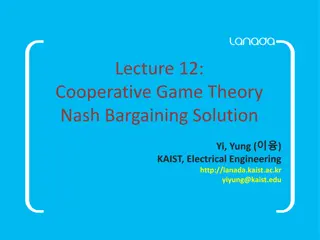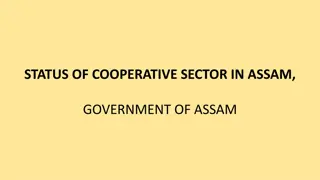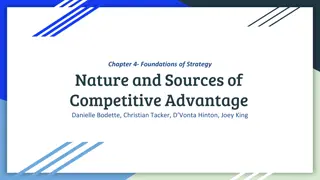Population Interactions in Nature: Competitive and Cooperative Interactions
Every population, whether animal or plant, engages in competitive and cooperative interactions to fulfill their needs for food, shelter, and resources. Intraspecific competition is common among individuals of the same species, leading to a struggle for survival. Interspecific interactions also play a role in shaping ecological balance and population dynamics. Understanding these population interactions is crucial for conservation and management efforts.
Download Presentation

Please find below an Image/Link to download the presentation.
The content on the website is provided AS IS for your information and personal use only. It may not be sold, licensed, or shared on other websites without obtaining consent from the author.If you encounter any issues during the download, it is possible that the publisher has removed the file from their server.
You are allowed to download the files provided on this website for personal or commercial use, subject to the condition that they are used lawfully. All files are the property of their respective owners.
The content on the website is provided AS IS for your information and personal use only. It may not be sold, licensed, or shared on other websites without obtaining consent from the author.
E N D
Presentation Transcript
Abhipedia IAS Environment & Ecology POPULATION ECOLOGY-2 Pritam Sharma Abhimanu IAS ABHIMANU IAS : COMPLETE GENERAL STUDIES PRE CUM MAINS COURSE CALL 7347432666, MAIL AT INFO@ ABHIMANU.COM.. 1
Abhipedia IAS POPULATION INTERACTIONS Every population is noted for exhibiting two types of interactions called as Competitive interactions and Cooperative interactions. Noted that both types of these interactions are more evident in animals than in plants for the obvious reason their being sessile in nature. Competitive intraspecific interactions: Since every individual in this nature needs food, space, protection from enemies and many other similar requirements of life. It thus always comes in contact with other organisms for the said purpose and competes with it. It is not easy to get all these requirements fulfilled as the earth is already crowded with life. There is competition among the organisms for their needs, and it may be quite intense. This means that ABHIMANU IAS : COMPLETE GENERAL STUDIES PRE CUM MAINS COURSE CALL 7347432666, MAIL AT INFO@ ABHIMANU.COM.. 2
Abhipedia IAS In nature no habitat is peaceful. The animals occupying it are engaged in killing others so that they themselves may live. Sparrows fighting with one another for shelter and wall lizards chasing each other to catch an insect are common sights in our houses. However, amid all this death and destruction, there always exists sort of a balance, ecological equilibrium, which permits the maximum individuals to live and leave their progeny. This natural balance is achieved by competition which in nature may manifest itself in two forms called as intraspecific and interspecific. Indeed, of the two types of interactions as we mentioned above, the so called ABHIMANU IAS : COMPLETE GENERAL STUDIES PRE CUM MAINS COURSE CALL 7347432666, MAIL AT INFO@ ABHIMANU.COM.. 3
Abhipedia IAS Intraspecific competition is always very fierce and severe because, all the members of a species have the same requirements of food and shelter, and they are nearly equal in their structural, functional and behavioural adaptations. This is the reason that the individuals of solitary animals often live spaced apart so that each has a better chance to satisfy its needs. This is why, many birds and mammals establish territories for the same purpose. No doubt, Intraspecific competition is maximum when the resources are limited. It may thus lead to overcrowding under which the individuals in excess will fail to get their requirements of food and shelter fulfilled and are thus eliminated. This is another reason for controlling the birth rate and hence population sizes.
Abhipedia IAS COMPETITION AMONG PLANTS Competition occurs in plants also. For example, seedlings growing under the parent tree seldom survive because of competition with the parent. Similarly, the seedlings growing close together also compete for space, light, water and minerals. In the process, those growing faster than others will succeed in getting their requirements fulfilled and thus able to survive, others however perish. In order to avoid competition, the mechanism of seed dispersal is used by the plants. Moreover, in some plants say for example, the roots of some desert plants tend to produce certain chemicals which check the germination of seeds within a certain distance to conserve scarce water and minerals.
Abhipedia IAS COOPERATIVE INTRASEPECIFIC INTERACTIONS Significance of cooperative interactions: In cooperative interactions, the members of a species work together to achieve the same end that is the survival of the species. Some of the important intraspecific cooperative interactions witnessed in the nature are: 1. Mating: Pairing of male and female individuals for the purpose of reproduction, is known as mating. For the purposes of mating, animals have evolved varied modes of copulation. Many, particularly birds and mammals, indulge in simple to elaborate courtship and pre-copulatory behaviour. Courtship involves singing, dancing, and presenting gifts by males to their female counterpart. MPLETE GENERAL STUDIES PRE CUM MAINS COURSE CALL 7347432666, MAIL AT INFO@ ABHIMANU.COM.. 6
Abhipedia IAS 2. Parental Care: It refers to an activity wherein the eggs or the young ones are being looked aftereither by one of the parents or by both. Care arises from responsibility or affection for others among the organisms and varies from mild attention to a profound concern. This behaviour manifests itself among organisms in many forms and modes such as: Ootheca formation in which case some animals lay food laden eggs in specialised protective egg cases called as Ootheca. Cockroaches and Earth Worm fall in this category. Similarly, Nest Building is another example of Parental care. Here the animals such as birds or insects build nests to store their eggs and guard them until they are hatched. For example,
Abhipedia IAS In the peacock, only the mother incubates the eggs and cares for the young. In crows and vultures, both the parents take part in nest building, incubation and feeding the young ones. Some animals also exhibit so called , parental care especially, caring the young. For example, among honey bees, the worker honeybees look after and feed the larvae with great care. The mother scorpion carries the offspring on the back for about a week. The mother crocodile looks after the eggs as well as the young ones when hatched. The female kangaroo protects and nourishes the very helpless young in her abdominal pouch called marsupium. Significantly, the Plants do exhibit this parental care. they nourish the young (embryos) and release them with various devices that protect them and help them to reach suitable sites so as to establish their permanent growth there.
Abhipedia IAS 3. Aggregation: Aggregation refers to the habitual occurrence of the individuals of a species in large groups for various purposes. In fact, Such aggregations among animals may be temporary or permanent. Say for example, the frogs exhibit a gregarious mode only for a temporary period for the purposes of breeding. Snakes are mainly solitary but hibernate in groups for warmth etc are some of the examples of temporary aggregations. On the other hand, some animals show permanent aggregations Birds, such as parrots, ducks and geese, always occur in flocks. Mammals, such as deer, antelopes, zebras, elephants, and lions live in herds. Monkeys and apes live in troops. Bats roost together in caves. A herd of African elephants usually consists of females and their young ones. The adult female is usually the leader of the herd. ABHIMANU IAS : COMPLETE GENERAL STUDIES PRE CUM MAINS COURSE CALL 7347432666, MAIL AT INFO@ ABHIMANU.COM.. 9
Abhipedia IAS Although, there many advantages that can accrue to animals from such aggregations, yet the most significant is protection against predators and other environmental hazards. It has been validly confirmed through many field observations and laboratory experiments that the individuals in an aggregation are more likely to survive than a single individual of the same species placed in the same environment. For instance, a herd of deer is less likely to be surprised by a predator than a single deer because of many noses and many pairs of eyes and ears. A pack of wolves is more likely to make a kill than a single wolf.
Abhipedia IAS 4. Altruism: Altruism is the behaviour exhibited by an organism whereby, an individual increases the welfare of another individual of its species at the expense of its own welfare. In altruism, the altruist suffers whereas the other individual is favoured (benefited). For example, when a herd of spotted deer is attacked by a predator, such as tiger or panther, the stag' having the best antlers is surrounded by other members of the herd, to save its life. As such, one or more surrounding defenders may likely be killed by the predators. Similarly, among honey bees, a worker bee sacrifices itself life for the sake of defending its hive. The sheer advantage that altruism fetches for the organisms is that it saves the best individual or the colony from death through sacrifice of life by one or more individuals. ABHIMANU IAS : COMPLETE GENERAL STUDIES PRE CUM MAINS COURSE CALL 7347432666, MAIL AT INFO@ ABHIMANU.COM.. 11
Abhipedia IAS 5. Dominance-Subordination behaviour: Dominance-subordination behaviour is a kind of hierarchical social order seen in a flock or herd in which there is ranking of individuals. High, ranking or dominant individuals casually displace the low-ranking or subordinate ones from areas of shelter and sources of food and water, whereas, low-ranking individuals withdraw or submit themselves on the approach of high-ranking ones. Each individual in a social group knows its rank, and all live peace-fully. If a conflict arises, the higher-ranking individual gives a formal threat display, and the lower-ranking one at once assumes a submissive or appeasement posture to avoid injury. Dominance once established is more or less permanent. However, a member of a lower rank may get a higher rank by defeating the senior ranks. Among animals, such dominance hierarchies have been found in fishes, lizards, mice, rabbits, wild dogs, wolfs, goats, horses, Lions, tigers, monkeys and apes etc..
Abhipedia IAS 6. Leadership behaviour: Leadership behaviour is a tendency on the part of the members of a group to follow a certain member called the leader. The leader keeps the other members of the group together when they are on the move. It is the leader, who determines the feeding and resting rhythms of the members in the herd. The relationship between the leader and the followers is different from that between the dominant member and the subordinates. The leader does not enjoy special social privileges and there is mutual dependence of the leader and the followers. This behaviour is commonly seen among Mammals such as in elephants, the herd is led by a female. A kangaroo herd is patriarchal in nature as it is generally led by an old male. In the red deer, the herd is also led by a female and is thus matriarchal in nature. ABHIMANU IAS : COMPLETE GENERAL STUDIES PRE CUM MAINS COURSE CALL 7347432666, MAIL AT INFO@ ABHIMANU.COM.. 13
Abhipedia IAS 7. Cannibalism: Cannibalism is an intraspecific interaction in which the larger members eat up the smaller ones of their own species. An individual that eats is known as a cannibal, and the one that is being eaten is called a prey. Cannibalism is common in insects such as cockroaches, ants and termites including among Cobras, Frogs and Scorpions. Ecologically, cannibalism has its own share of advantage especially, limiting the size of the population. 8. Animal Societies: Certain insects, namely, termites, bees, ants and wasps, form well organized and highly integrated societies. For example, in such a society, a large number of individuals of the same species live together in some sort of a nest which may be called as hive or comb in honey bees; termitarium or termite hill in termites and formicarium in ants.
Abhipedia IAS The individuals in all such insect societies are morphologically specialized into distinct types so called as castes (polymorphism) for performing different activities or jobs (division of labour). Each individual contributes to the welfare of the entire colony. In all such societies, there are three. main castes : queen, males (drones in bees and kings in other social insects) and workers. The first two are reproductive individuals, The workers perform all other duties such as preparation of nest, collection and storing of food, rearing of young ones and protection of the colony from predators. In Termites however, in addition to the workers, there are soldiers too, meant to fight the intruders as well as for fighting a chemical warfare. Ants cultivate fungus gardens and rear ant cows (aphids) for feeding. ABHIMANU IAS : COMPLETE GENERAL STUDIES PRE CUM MAINS COURSE CALL 7347432666, MAIL AT INFO@ ABHIMANU.COM.. 15
Abhipedia IAS 9. Communication: Communication means transmission or exchange of information among the members of a species. This transmission takes place through some kind of signals which may be chemical, tactile, visual, auditory or electrical in nature. For example, the chemical signals are known as Pheromones which are detected by smell or taste. For example, foraging ants leave behind so called a trail substance which is a chemical pheromone along their path so that the other workers of the colony may find their way to the food and back home after gathering food. Similarly, the female Silk moth secretes bombykol as a sex attractant. Musk Deer secretes Muskeon both for marking a territory and as a sex attractant during the breeding season. The animals also communicate through tactile signals, visual and auditory signals such as (chirps, grunts, snorts, roars, squeaks) to express distress, hunger, threat, mating desire and anger among almost all mammals .
Abhipedia IAS Thank You ABHIMANU IAS : COMPLETE GENERAL STUDIES PRE CUM MAINS COURSE CALL 7347432666, MAIL AT INFO@ ABHIMANU.COM.. 17























